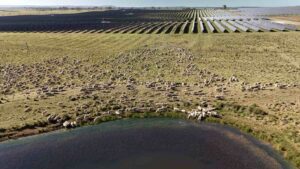The federal Coalition government has achieved what most would have assumed impossible at the start of 2018: its position on climate and energy policies has worsened and shifted even further to the right.
The acrimony at the COAG energy minister’s meeting in Adelaide underlined the extent to which the Coalition policies make no sense. Even their state Liberal counterparts agree on this point.
At COAG, the Coalition, via the energy minister Angus Taylor, refused to even discuss the issue of emissions, prompting outrage by a NSW conservative government that is worried about its fate in an upcoming state election, and gleefully echoed by the Labor states.
Taylor is the self-described “minister for lowering prices”, but he can’t even get that bit right.
Gas prices are rising, and at COAG he was whacked across the head by a report from the country’s conservative rule maker, the AEMC, which concluded that his signature policy – forcing retailers to cut their default tariffs – was likely to put prices up for most customers. As was widely predicted.
To top off the complete disaster that is this country’s energy policy, a much needed proposal to lift Australia’s slack energy performance standards on new houses was deferred at the request of Tasmania.
Australia may have lots of wind and solar, but it trails the world by years in emission and efficiency standards on buildings, transport and generators. Australia makes a virtue of being inefficient, and the big utilities who have argued against such measures pocket the profits from increased generation.
The only thing that COAG could agree on was a reliability obligation that likely won’t be needed for a decade, and the need for a hydrogen strategy that would only make sense if Australia was to get near 100 per cent renewables. (And the hydrogen industry is very quiet on that front.)
But this is where the Coalition has left climate and energy policy at the end of 2018. The domestic policy settings are in disarray, the Coalition continues to mislead on emissions, it hails the benefits of the wind and solar additions it sought to stop, but says it wishes to add no more.
And they are egged on by what former prime minister Malcolm Turnbull calls the “idiots and ideologues” on the far Right. And there they were, on cue, in the Murdoch media on Thursday morning defending Taylor, and sniping at the Liberal moderates.
The influential Institute of Public Affairs, the climate-denying “think tank” largely sponsored by Gina Rinehart, wrote an opinion piece for the Daily Telegraph describing the NSW policy of reaching zero net emissions by 2050 as an attack against “ordinary people” and a contest between “Penrith and Paris.”
The piece written by the IPA’s director of economics, Daniel Wild, was full of the usual disinformation on renewables and subsidies, and the usual nonsensical argument that setting down the entire Australian economy would make no noticeable difference to global climate.
Wild cited the case of Bluescope and other manufacturers burned by high electricity prices. Indeed they have been – but how has Bluescope and the likes of steel billionaire Sanjeev Gupta responded? By turning to solar to lock in cheaper power. Wild didn’t mention that bit.
Wild’s comments were echoed by the equally extreme climate science denier Andrew Bolt, who said a 45 per cent cut in emissions was crazy, because it wouldn’t make a difference to global temperatures, and because the temperature rises experienced so far had been positive, delivering record crops and fewer cyclones.
The Australian newspaper rolled out the usual suspects to try to justify the mess. Highly paid economics contributor Judith Sloan accused Harwin of “going rogue”, and produced the usual nonsense about renewables, including describing a new link between South Australia and NSW as an act of madness.
As a song from three energy campaigners suggests, the Coalition actually believes this rubbish. (To be sung to the tune of John Schumann’s I was only 19).
“Though the sun shines on our rooftops, And the wind blows through the trees, And every energy contract proves the cheapest power is green, half the Coalition seems convinced that coal is clean. God help me, it’s 1919.”
The Coalition, at the behest of such commentators, goes into the New Year, and likely a federal election in March or May, with no policy to reduce emissions, boasting only of the electricity sector that will deliver its “share” of emissions reductions eight years early.
Even this was achieved through a policy, the renewable energy target, that they tried to destroy. If you really want to know what they think about this $15 billion of investment, count how many times the Coalition energy minister turned up at the opening of one of the 30 wind and solar farms that began operations this year.
Normally, the saying goes, you can get a minister to turn up at the opening of an envelope. But as far as we can tell, neither Josh Frydenberg nor Angus Taylor visited a single one. Taylor, a long time campaigner against wind energy, didn’t even accept an invitation to attend the opening of a $200 million wind farm in his own electorate.
Because of this pressure from within and without, the Coalition refuses to use cheap wind and solar to go further on emissions cuts, which even their own government-owned utility says is the cheapest form of generation, even when backed up and “firmed”.
Instead, it makes a virtue of bringing the installations to a halt, and would rather concoct a scheme for new dispatchable generation, that will likely result in a life extension for the Vales Point coal generator, an idea that has been prettied up by the recent signing of a long-term contract with the Darlington solar farm.
As for NSW, there is no doubt that Harwin’s intervention was motivated by the timing of the upcoming state election, and what the NSW Coalition has witnessed in its own by-election in Wagga, the Wentworth drubbing, and the decisive victory for Labor in Victoria, including the unseating of a long-term conservative by yet another pro-climate independent.
Harwin, and for that matter NSW Labor, have not delivered any state-based targets to date. If they did, it would be largely academic because the state faces the biggest transformation of them all – how to replace the majority of coal-fired generators that will have to retire over the next 15 years.
This makes Harwin’s target of zero net emissions a reasonably safe bet, given that by that time the electricity sector will be largely decarbonised, and transport and much of manufacturing along with it.
The only thing that NSW, the other states, and just about everyone else apart from the “idiots and ideologues” identified by Turnbull wish to have is some sort of federal policy that recognises the clean energy transition and the opportunities and benefits that it could deliver. And to ensure it happens in an orderly fashion, not brought to a halt.
It won’t be in anyone’s Xmas stocking. Maybe by Easter?










